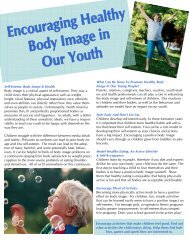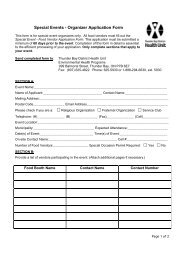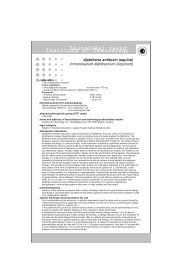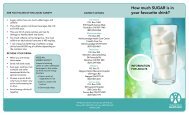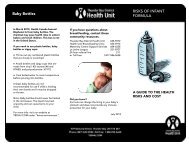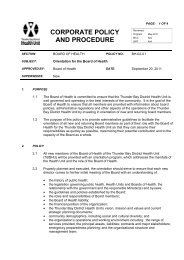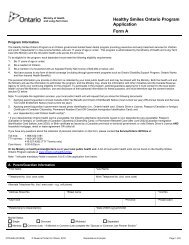Ticks and Lyme Disease - Thunder Bay District Health Unit
Ticks and Lyme Disease - Thunder Bay District Health Unit
Ticks and Lyme Disease - Thunder Bay District Health Unit
You also want an ePaper? Increase the reach of your titles
YUMPU automatically turns print PDFs into web optimized ePapers that Google loves.
<strong>Ticks</strong> <strong>and</strong> <strong>Lyme</strong> <strong>Disease</strong><br />
learn about ticks<br />
<strong>and</strong> prevent tick bites<br />
<strong>and</strong> <strong>Lyme</strong> disease.
Most ticks in the <strong>Thunder</strong> <strong>Bay</strong> <strong>District</strong> are<br />
harmless. However, there are deer ticks in<br />
the area that carry <strong>Lyme</strong> disease. Although<br />
the risk to humans is low because of THE<br />
small number of deer ticks, the <strong>Health</strong> <strong>Unit</strong><br />
recommends taking safety measures to<br />
prevent tick bites.<br />
What is the difference between a wood tick <strong>and</strong> a deer tick?<br />
Wood Tick<br />
Wood ticks are the most common<br />
tick in the <strong>Thunder</strong> <strong>Bay</strong> <strong>District</strong>.<br />
Female wood ticks have a white<br />
hood or shield behind their head.<br />
Male wood ticks have a black <strong>and</strong><br />
brown shell. They are harmless to<br />
humans but can be a nuisance.<br />
Deer Tick<br />
Deer ticks have potential to carry<br />
<strong>Lyme</strong> disease. They are brown<br />
or black with no white markings.<br />
Females may have a coloured body.<br />
Due to milder winters, an increasing<br />
number of deer ticks have been<br />
identified in the <strong>Thunder</strong> <strong>Bay</strong> <strong>District</strong>.
How can I remove a tick <strong>and</strong> what do I do with it?<br />
You will need a pair of fine-tipped tweezers, soap <strong>and</strong> water, some rubbing<br />
alcohol <strong>and</strong> an empty container.<br />
1. Remove the tick.<br />
• Use fine-tipped tweezers<br />
to grab the head <strong>and</strong> mouth<br />
as close to the skin as possible.<br />
• Pull up slowly until the tick is<br />
completely removed from the<br />
skin. Do not twist or turn. Try<br />
not to damage the tick so it<br />
can be easily identified.<br />
• Do not try to burn the tick or<br />
use anything to smother it<br />
(e.g. Vaseline ® ).<br />
• Make sure the whole<br />
tick is removed.<br />
• Put the tick in a clean<br />
container or empty pill bottle.<br />
Mark down the date <strong>and</strong> the<br />
geographic location of where<br />
the tick bite happened.<br />
Use tweezers to grab the head<br />
<strong>and</strong> mouth as close to the skin<br />
as possible <strong>and</strong> pull up until<br />
the tick is completely removed<br />
from the skin.<br />
2. Treat the bite.<br />
• Wash the area with soap <strong>and</strong> water <strong>and</strong> then apply rubbing alcohol.<br />
3. Bring the tick to the <strong>Health</strong> <strong>Unit</strong> for identification.<br />
• <strong>Thunder</strong> <strong>Bay</strong>: Drop off at the 999 Balmoral Street office.<br />
• Outside of <strong>Thunder</strong> <strong>Bay</strong>: Drop off at the nearest <strong>Health</strong> <strong>Unit</strong><br />
branch office.
How can I protect myself against ticks <strong>and</strong> <strong>Lyme</strong> disease?<br />
<strong>Ticks</strong> are very hardy, difficult to kill <strong>and</strong> will survive without feeding<br />
<strong>and</strong> with little oxygen. If you are planning an outside activity, there are<br />
some tips you can follow. These tips are even more important if you are<br />
planning a trip to an area with lots of ticks, or if you are out in the bush<br />
during the spring when ticks are most active.<br />
• Avoid places with long grasses. If you are hiking or walking, stay<br />
in the centre of the trail.<br />
• Wear light coloured clothing to make it easier to find the ticks.<br />
• Wear clothing that covers as much skin as possible.<br />
• Wear long sleeved shirts that fit tightly around your wrists.<br />
• Keep long pants tucked into your socks.<br />
• Use an insect repellant with DEET on uncovered skin as well as<br />
on your clothing.<br />
Follow these guidelines from <strong>Health</strong> Canada:<br />
Infants under 6 months • Do not use a DEET repellant.<br />
Children between six<br />
months <strong>and</strong> two years<br />
Children<br />
Adults<br />
• Use a repellant only if there is a high<br />
risk of insect bites.<br />
• Use a product with 10% DEET or less.<br />
• Do not put the repellant on their face<br />
or h<strong>and</strong>s.<br />
• Use a product with 10% DEET or less.<br />
• Do not put on the repellant more<br />
than three times per day.<br />
• Use a product with 30% DEET or less.<br />
Pregnant women<br />
• There is no evidence to prove that<br />
DEET will harm pregnant or breastfeeding<br />
women. But, these women<br />
may want to use non-chemical ways<br />
to prevent bites.
• Check yourself, your children<br />
<strong>and</strong> your pets from head to toe<br />
for ticks before you go indoors.<br />
• Have a hot shower after<br />
checking for ticks, if possible.<br />
• Wash your clothes with hot<br />
water <strong>and</strong> use the hottest<br />
setting on your dryer to kill any<br />
ticks that you may have missed.<br />
This is an engorged tick. Make sure<br />
you check your animals for ticks <strong>and</strong><br />
remove right away. Use tweezers<br />
<strong>and</strong> follow the method described<br />
earlier in the brochure.<br />
What is <strong>Lyme</strong> disease <strong>and</strong> how is it spread to humans?<br />
<strong>Lyme</strong> disease is a serious illness<br />
that affects the central nervous<br />
system, the cardiovascular system<br />
(e.g. heart <strong>and</strong> lungs), <strong>and</strong> the<br />
joints. Although <strong>Lyme</strong> disease<br />
in humans can have serious<br />
symptoms, it can be treated if it is<br />
noticed early enough.<br />
<strong>Lyme</strong> disease is caused by a<br />
bacteria that is spread through the<br />
bite of infected deer ticks. Deer<br />
ticks feed on infected animals<br />
(e.g. mice, squirrels, birds) <strong>and</strong><br />
pick up the bacteria. The deer ticks<br />
then spread the disease to humans<br />
through a bite.<br />
<strong>Lyme</strong> disease is not spread directly<br />
from person-to-person or from petto-person<br />
by touching or kissing.<br />
Female deer ticks in different<br />
stages of feeding. Notice the<br />
change in both size <strong>and</strong> colour.<br />
The largest tick is fully engorged<br />
after feeding.<br />
Source: Public <strong>Health</strong> Agency of Canada;<br />
Photographer: Robbin Lindsay, 2006.
What are the symptoms of <strong>Lyme</strong> disease <strong>and</strong> how is it treated?<br />
Tick bites are usually painless <strong>and</strong><br />
most people don’t even realize<br />
they have been bitten. The signs<br />
<strong>and</strong> symptoms of <strong>Lyme</strong> disease are<br />
different from person to person.<br />
In a few cases, the first sign of infection<br />
may be a “bulls-eye rash.” This rash<br />
can show up any time from three days<br />
to one month after the bite.<br />
Other symptoms might include:<br />
• Fatigue or exhaustion<br />
(e.g. being very tired)<br />
• Fever<br />
• Headache<br />
• Muscle <strong>and</strong> joint pain<br />
• Swollen lymph nodes<br />
(e.g. under the jaw bone,<br />
in the arm pits)<br />
If the infection is not found,<br />
the symptoms could get worse<br />
<strong>and</strong> include:<br />
• Arthritis <strong>and</strong> arthritic symptoms (e.g. achy, stiff <strong>and</strong> swollen joints)<br />
• Heart palpitations (e.g. heart all of a sudden beats very quickly,<br />
or very slowly)<br />
• Extreme fatigue or exhaustion<br />
The “bulls eye rash” may be the<br />
first sign of an infection. This rash<br />
can show up any time from three<br />
days to one month after the bite.<br />
Many antibiotics are effective in treating <strong>Lyme</strong> disease, especially<br />
when treatment starts early.
Where can I get more information?<br />
For more information about ticks <strong>and</strong> <strong>Lyme</strong> disease, please call<br />
a Public <strong>Health</strong> Inspector in the Infectious <strong>Disease</strong> program at<br />
625-8318 or 1-888-294-6630, ext. 8318.<br />
You can also visit these reliable websites <strong>and</strong> search under<br />
“<strong>Lyme</strong> disease” or “ticks”:<br />
Ontario Ministry of <strong>Health</strong> <strong>and</strong> Long-Term Care<br />
www.health.gov.on.ca<br />
Public <strong>Health</strong> Agency of Canada<br />
www.phac-aspc.gc.ca<br />
<strong>Health</strong> Canada<br />
www.hc-sc.gc.ca
<strong>District</strong> Offices<br />
Geraldton<br />
P.O. Box 1360<br />
510 Hogarth Avenue West<br />
Geraldton, ON P0T 1M0<br />
(807) 854-0454<br />
Manitouwadge<br />
P.O. Box 385<br />
Manitouwadge <strong>Health</strong> Care Centre<br />
1 <strong>Health</strong> Care Cre.<br />
Manitouwadge, ON P0T 2C0<br />
(807) 826-4061<br />
Marathon<br />
P.O. Box 384<br />
Marathon Library Building<br />
24 Peninsula Rd.<br />
Marathon, ON P0T 2E0<br />
(807) 229-1820<br />
Nipigon<br />
P.O. Box 15<br />
Nipigon <strong>District</strong> Memorial Hospital<br />
125 Hogan Rd.<br />
Nipigon, ON P0T 2J0<br />
(807) 887-3031<br />
Schreiber<br />
P.O. Box 698<br />
Jack Stokes Medical Building<br />
501 Scotia St.<br />
Schreiber, ON P0T 2S0<br />
(807) 824-2413<br />
999 Balmoral Street, <strong>Thunder</strong> <strong>Bay</strong>, ON P7B 6E7<br />
Phone: (807) 625-5900 | Toll-Free: (888) 294-6630<br />
TBDHU.com





